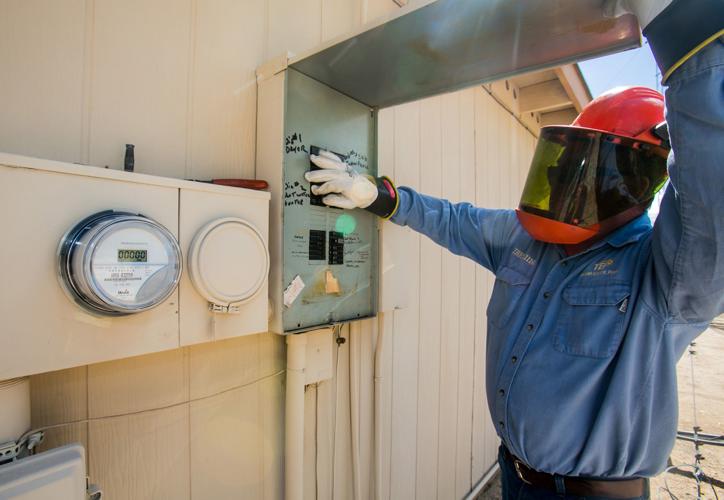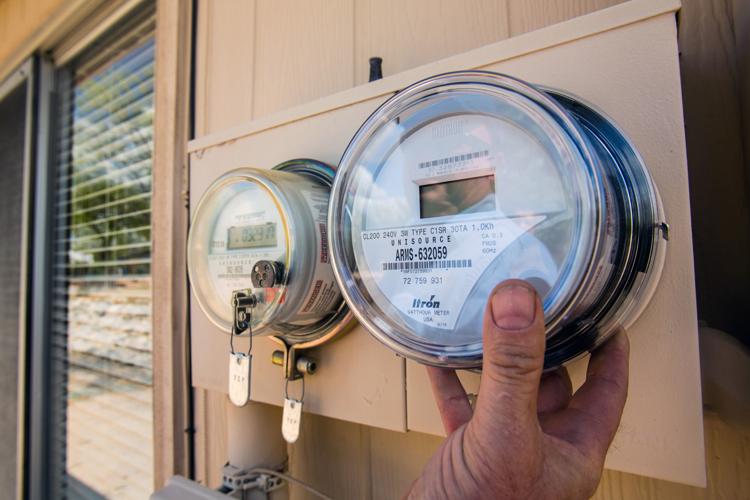Tucson Electric Power has rolled out new rate options that could help customers trim their bills — or if they’re not careful, cost them more.
New TEP rates approved by state regulators in February include optional “time of use” residential rate plans, which feature higher rates for power used during peak periods — 3 to 7 p.m. in the summer — and lower rates for off-peak usage.
For the first time, TEP also is offering residential customers optional “demand” rates that base part of the bill on a period of peak usage in a month, along with a hybrid time-of-use plan with a demand charge. Similar time-of-use and demand plans are available for TEP’s small general service business customers.
Existing TEP customers need do nothing to keep their current rate plans, which rose an estimated $8 a month for the typical home customer as a result of the recent Arizona Corporation Commission decision.
TEP is still providing a traditional, two-part residential rate, with a basic monthly service charge plus usage charges that increase as customers hit certain usage tiers.
As a result of the recent rate ruling, TEP’s time-of-use rate soon will become the “default” for all new customers, though they may opt for other plans.
As an incentive to sign onto time-of-use or demand rates, customers pay a monthly service charge of $10, compared with $13 for the basic rate.
TEP says customers can save money on their bills with time-of-use or demand rates, while helping to reduce overall peak power demand that drives overall grid costs.
TEP’s service costs are driven by the need to satisfy customers’ highest demand, even if it only occurs once each month, so prompting customers to limit their peak demand helps keep costs down for everyone, TEP spokesman Joe Barrios said.
“The idea is that now, providing rates that reflect those costs to the customers, ideally that could have a impact on demand,” Barrios said, adding that TEP has no current plans to propose mandatory time-of-use or demand rates.
RATE TRENDS
Utilities and state regulators across the nation are looking at new rate designs to offset a slowdown in demand for power attributed to factors such as wider adoption of energy-efficient technologies, a decline in manufacturing, the growth of customer-owned solar energy systems and general consumer belt-tightening.
An analysis of alternative rate designs last year by the non-profit Rocky Mountain Institute found that time-based rates have the potential to cut peak power loads by up to 50 percent and reduce usage by up to 10 percent.
But although utilities in 49 states and the District of Columbia have time-based rates, adoption remains low at just 4 percent of residential utility customers enrolled, the Rocky Mountain Institute found.
An Arizona consumer advocate agreed that time-of-use rates can save money for ratepayers and their utilities.
“But if ratepayers switch to a TOU or demand rate without altering their electric use, they could experience a significant increase in their monthly bills,” said Diane Brown, executive director of the Arizona Public Interest Research Group.
Such rates should not be mandatory, and even making them the default for new customers is concerning, Brown said.
She said many customers — particularly low-income and fixed-income ratepayers — can’t easily modify how or when they use power because they are homebound, work from home, have varying work schedules or have large households.
“Our overall view is that customers, not TEP, should determine at the onset which rate plan best suits their needs,” Brown said.
DEMAND RATES
Demand rates have mainly been used by commercial customers of TEP and other utilities, but Arizona Public Service Co. has had long experience with such rates.
APS, Arizona’s largest state-regulated utility, instituted a mandatory demand rate for home customers with central air conditioning in 1981.
Later in the 1980s, APS added time-of-use rate options and made demand rates optional.
But as of last year, more than 110,000 or about 11 percent of APS customers are on voluntary demand rates, and nearly 40 percent of APS customers are on time-of-use rates.
TEP has been slightly behind the curve in adopting time-sensitive rates. Barrios acknowledged TEP has been slower than APS and other peers to install new “automatic meter reading,” or AMR, meters, partly because TEP was searching for the most cost-effective technology.
TEP has offered time-of-use rates for years and has about 10,000 or about 4 percent of its customers on such rates, Barrios said.
Those existing time-of-use customers have been switched to updated TOU rates, Barrios said, noting that the peak summer rate period has been cut by an hour.
He also noted TEP has long offered demand rates to commercial customers, but new time-of-use and demand options are available to the smallest business class, small general service.
BILL SPIKES
TEP’s new residential demand rate features a charge for the highest one-hour period of usage during peak demand periods each month, measured in kilowatts (as opposed to the kilowatt hours used to measure consumption).
Demand-rate customers also pay a basic monthly charge of $10 and pay energy usage charges, billed in kilowatt-hours, that are lower than energy charges under the basic, flat-rate plan.
TEP’s demand charge is $8.85 per kilowatt up to 7 kW usage, with the rate for demand above 7 kW rising to $12.85 per Kw.
Such demand can roughly be calculated by the rating of each energy-using device, but it takes some research and some vigilance to know what’s turned on and when.
Depending on their size, central air conditioners alone demand from 3 to 5 kilowatts, and adding high-demand appliances such as electric dryers can quickly boost the demand charge.
Arizona PIRG’s Brown said demand rates are more complicated than other plans and require careful energy management to avoid bill spikes.
“A demand charge based on an hour usage instead of a month can really trigger a hefty electric bill,” she said. “Demand-charge plans really need good educational materials and utility staff to work with ratepayers to understand how to best utilize their plan.”
TEP’s new rates are detailed on the company’s website, and brochures explaining the rate options are on the way.
Brown noted that APS in its pending rate case initially sought to mandate demand rates for most of its residential customers, which was met with opposition from consumer advocates.
Under a pending rate settlement, new APS customers would be required to sign up for demand or time-of-use rates and use them for three months before being allowed to switch to the standard flat-rate plan.
Noting that the Corporation Commission also rejected mandatory demand rates in a rate case of UNS Electric, a sister company to TEP, Brown said regulators seem to agree that the public isn’t ready for mandatory demand rates.





